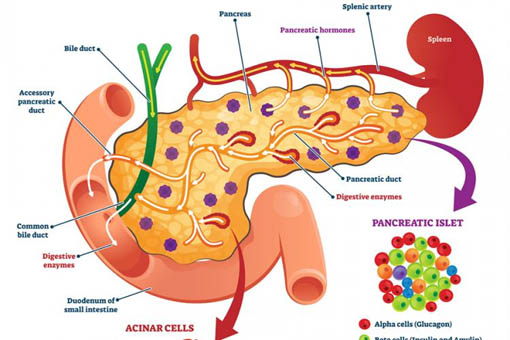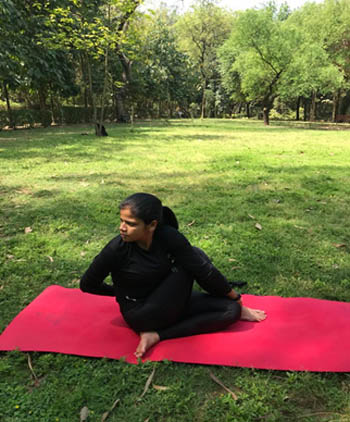Ardha Matsyendrasana (अर्धमत्स्येन्द्रासन) is the single sitting yogasana, which is capable in the prevention of diabetes, if it is performed systematically. Though, it’s a little bit advanced yoga pose in respect of technique but one can learn it by following its simple steps. Learn step by step technique of Ardha Matsyendrasana. It is known by different names like Half Lord of Fishes pose, half spinal twist pose, Vakrasana, so on. Ardha Matsyendrasana is a Sanskrit word comprising (ardha-matsya-eendra-asana). It helps to massage the kidneys, pancreas, small intestines, etc. It also enables to stimulate digestion and squeeze out toxins. It is quite useful for diabetics, with concentration on the pancreas. To perform it, you may sit on the carpet, stretch the legs straight.

Steps
- Sit in Vajrasana position or sit straight with stretching your legs in front of you.
- Bend your left leg and try to touch your feet to your right buttock as shown in the above image.
- Bring your right leg outside of the left knee. Touch your feet to the ground. Keep your spine erect.

- Exhale and turn your upper body to the right. Hold your right feet with a left hand and place your right hand behind you are on the ground as shown in the above image.
- Breathe normally and hold this posture for 20 to 30 seconds. After practice, you can hold this posture for 3 to 5 minutes.
- Now release this posture and repeat this cycle with bending the right leg and bringing left leg outside of the right knee. (i.e. Twisting the opposite direction).
Benefits
- Good for increasing the flexibility and function of vertebrae of the spine.
- Stretches back muscle and spine.
- Cures constipation and indigestion.
- Helps to increases oxygen supply to the lungs.
- Releases stiffness of hip joints.
- Beneficial for slipped disc patient.
- Cures back problems.
- Increases blood circulation to pelvic region as well as improves the function of reproductive organs.
- Effective to cure menstrual problems in women.
- Helpful in treatment of diabetes, constipation, spinal problems, Cervical Spondylitis, Urinary tract disorder.
Precautions
- Should be avoided during pregnancy and periods.
- Heart problems patient and abdominal surgery should not practice this asana.
- Those suffering from severe spinal problems should not practice.
- Should be done under the expert guidance and consult a doctor before practicing any exercise.
Studies conducted by researchers from across the world have confirmed our age old wisdom – yoga has immense physical and mental benefits for people suffering from chronic and non- communicable diseases, especially diabetes. For one, regular yogic practice stimulates the organs that are responsible for improving metabolic activity. As a result, the cellular reactions happen more efficiently, making it extremely beneficial for people suffering from diabetes. Being a diabetic can be very difficult since lack of insulin production can lead to metabolic imbalances that disrupt the regulation of glucose levels in the body.
Studies have proven that regular practice of yoga can lead to improvements in both cholesterol and fasting glucose levels. Stimulating the pancreas with the help of yoga postures helps rejuvenate insulin production. Some asanas also help stimulate the circulatory and nervous system, keeping the blood sugar levels in check. Research has shown that regular practice of yogaasanas, like Ardha Matsyendrasana in combination with Vakrasana, Dhanurasana & Bhujangasana helps to improve the sensitivity of B-cells to glucose and thereby promotes insulin secretion.
The practice of asanas also helps to increase blood circulation which in turn helps to improve Glucose uptake. Improvement in hormone homeostasis also improves glycemic control in people with diabetes. Apart from asanas, practicing breathing exercises like kapalbhati and anuloma viloma is also extremely beneficial. Anuloma viloma is an alternate breathing technique that soothes your nervous system and helps the bodily systems maintain equilibrium. This also helps abate stress, which is another potential contributor to hyperglycemia.
Kapalbhati stimulates the production of insulin, and when combined with Nauli Kriya, it really helps keep the blood sugar levels in check. A satvik diet rich in fiber, legumes, whole grains and vegetables is a perfect complement to the exercise regimen.
 |
Dr. Sujata Panda, PhD in Yoga, DNYS, N.D., Gold medallist, Founder of Su-Ham Foundation Owner of Viroga Virtual Clinic |


